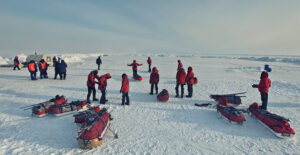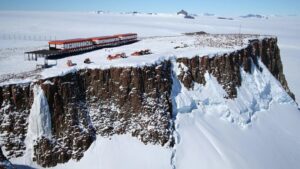Although I’ve done many expeditions to both the North and South Poles, both as an independent traveler and a guide, every fresh trip brings up new gear ideas. There are also old, tried-and-true standards that I have used for years. As I begin the South Pole season, let’s take a look at my gear. Today: ski poles.
One note: Proper gear is just one aspect of polar travel. Developing skills, planning and logistics, understanding the polar environment, and knowing how to minimize risk are all equally important. If you would like to fast-track your development as a polar traveler, consider hiring an IPGA guide.
Poles
I’ve used carbon fiber poles on long trips, and they are prone to breaking. Also, avoid folding poles (with the internal wire) as repairs can be really difficult. I used them once; never again.
I prefer all-aluminum two-piece telescopic poles to 155cm. Although I keep my poles relatively short (for warmer hands), I prefer long telescopic poles. On long trips, I get a sore shoulder and a fully extended pole alleviates the ache.
Telescopic poles are also excellent on mountain traverses (uphill pole shortened, downhill lengthened) and logical in guiding situations to cater to different heights. Use an external fliplock rather than internal camming for securing the length. Shock suspension is not needed. It just adds weight and complication.

A snowshoer traverses a slope near Mt Kosciuszko, Australia. Photo: Eric Philips
I attach ribbons to both poles to indicate wind strength and direction. This is very useful for navigating in poor light.
The basket must be pivotable 360º. Otherwise, it’s liable to catch on the snow when you de-pole. Once, I used a team member’s pole with a fixed basket for a day, and the difference was remarkable. I was very happy to return them. Leather cross braces inside an aluminum ring are a bombproof solution.
The tip should be made of steel or tungsten carbide for durability and must be circular concave, not uni-directional as on Nordic racing poles. This gives good traction in every direction and is particularly important on Arctic Ocean expeditions. Here, you must often use poles at every angle to balance amid pressure ridges.
Ski pole grips
I’ve heard mixed reviews about using pogies in Antarctica, usually with light gloves. These are big mittens that attached directly to the ski pole. You slip your lightly gloves hands into them. I’ve never used pogies, and they are not viable on the Arctic Ocean, where you often have to change from skis to boots and manhandle sleds.
Ski pole straps and techniques are also important. We teach people to use different techniques, depending on circumstances. It seems to me that the Scandinavian method (as seen below) can place a lot of pressure on the wrist where blood is near the surface.

The Scandinavian method. Photo: Eric Philips
I prefer the typical alpine ski method, below, where veins are not compressed and I can push on the pole with relaxed hands, not forcing blood out of my fingers.

The alpine ski method. Photo: Eric Philips
Pole straps should be long and adjustable, and the pole should have a foam extension below the handle for the lower grip.

Photo: Eric Philips






